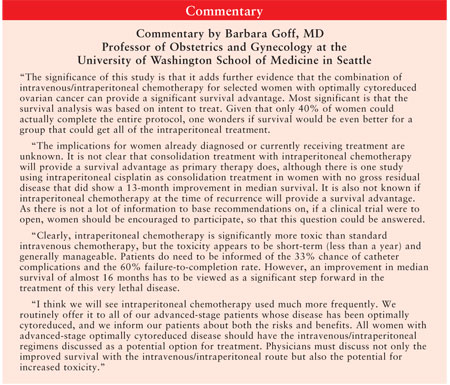US
Pharm. 2006;4:11-12.
A treatment approach
combining standard intravenous chemotherapy with chemotherapy administered
directly into the peritoneum resulted in a 25% reduction in the risk of death
for patients with stage III ovarian cancer and added a median of 16 months'
overall survival, compared with results from standard chemotherapy, a new
study in the New England Journal of Medicine has found.1 But
the researchers also found that patients in the intraperitoneal therapy group
reported poorer quality of life during treatment, and less than half were able
to complete all of the assigned intraperitoneal chemotherapy. Quality-of-life
differences between treatment groups had abated one year after treatment. The
substantial reported benefit caused the National Cancer Institute (NCI) to
issue a clinical announcement encouraging widespread use of this treatment
approach.2
Ovarian cancer is the most
deadly gynecologic cancer, primarily because typically it has spread beyond
the ovary by the time it is diagnosed. Despite the fact that surgery and
standard chemotherapy, usually consisting of a platinum analogue and
paclitaxel, lead to clinical remission in many patients, most patients will
experience a relapse and ultimately die of the disease.
The Intraperitoneal
Advantage
Intraperitoneal
chemotherapy is thought to have an advantage over standard intravenous
chemotherapy because it can expose the peritoneum, the site of the cancer, to
highly concentrated antitumor drugs while sparing, relatively speaking, normal
tissues--like bone marrow--that are affected by standard chemotherapy. Although
this form of therapy has been in use for some time, it is not widely
practiced, and the improved outcomes demonstrated in two previous studies have
not altered acceptance of intraperitoneal therapy by clinicians.
In this study, which was
conducted by the Gynecologic Oncology Group and headed by Dr. Deborah
Armstrong, participants had stage III epithelial ovarian carcinoma or
peritoneal carcinoma that had been surgically reduced to a residual mass no
greater than 1.0 cm in diameter. Researchers treated a total of 415 women in
the study. Patients assigned to the intraperitoneal group (210) received six
cycles of intravenous paclitaxel on day 1, followed by intraperitoneal
cisplatin on days 2 and 8 of a three-week period. Drugs were administered
through an implantable peritoneal catheter. Patients assigned to the
intravenous group (205) received paclitaxel on day 1, followed by cisplatin on
day 2 of each cycle.
Upon patient entry to the
phase III study and at regular intervals throughout, quality of life was
assessed. The Functional Assessment of Cancer Therapy–Ovarian instrument was
administered at registration, before cycle 4, several weeks after cycle 6, and
one year after completion of treatment. Patients were followed until death or
for about five years after treatment.
Survival Benefit
The primary end
points of the study were progression-free survival and overall survival.
Overall survival was measured from randomization to death or last contact;
death from all causes was included in the calculation of overall survival.
Progression-free survival was measured until the cancer progressed, the
patient died, or the last contact occurred, whichever came first.
Recipients of
intraperitoneal therapy gained a median of five additional months of
progression-free survival over the intravenous therapy group (relative risk
[RR], 0.80; 95% CI, 0.64 to 1.00; P = .05) and showed a median overall
survival gain of 16 months (RR, 0.75; 95% CI, 0.58 to 0.97; P = .03).
At the end of the follow-up period, 60% of patients receiving standard
intravenous chemotherapy had died, versus 49% of those receiving
intraperitoneal therapy.
These gains were offset by
poorer quality of life for intraperitoneal therapy patients during treatment,
as measured before the fourth cycle (P < .001) and three to six weeks
after the final cycle (P = .009). At 12 months, no significant
differences in quality of life were found. Only 42% of patients who started
intraperitoneal treatment were able to complete all six cycles of the assigned
chemotherapy, while 83% of the intravenous group completed their assigned
chemotherapy. Complications resulting from the catheter were the chief reason
for discontinuing intraperitoneal therapy. In addition, in the intraperitoneal
therapy group, significantly more patients reported severe fatigue, pain, or
life-threatening hematologic, gastrointestinal, metabolic, or neurologic toxic
effects (P <= .001) than in the intravenous group.
The authors suggest that
tolerability may be improved by screening out patients at risk of poor
tolerance, modifying the drug dosage and administration schedule, and using
less toxic alternative drugs.
In a statement issued by the
NCI, Dr. Armstrong said, "There has been a prejudice against intraperitoneal
therapy in ovarian cancer because it's an old idea, it requires skill and
experience for the surgery and for the chemotherapy, and it's more complicated
than intravenous chemotherapy. But now we have firm data showing that we
should use a combination of intraperitoneal and intravenous chemotherapy in
most women with advanced ovarian cancer who have had successful surgery to
remove the bulk of the tumor."2
Links to a list of medical
centers nationwide with expertise in administering this combined chemotherapy,
and to the NCI clinical announcement, can be found online at
ctep.cancer.gov/highlights/ovarian.html.
--Moira Flaherty

REFERENCES
1. Armstrong DK,
Bundy B, Wenzel L, et al, for the Gynecologic Oncology Group. Intraperitoneal
cisplatin and paclitaxel in ovarian cancer. N Engl J Med.
2006;354:34-43.
2. National Cancer
Institute. NCI Issues Clinical Announcement for Preferred Method of Treatment
for Advanced Ovarian Cancer. Available at:
www.cancer.gov/newscenter/pressreleases/Ipchemotherapyrelease. Accessed
January 23, 2006.
To comment on this article, contact editor@uspharmacist.com.





